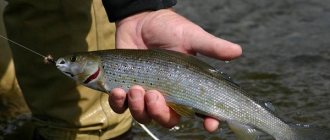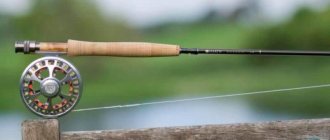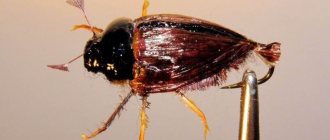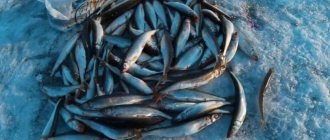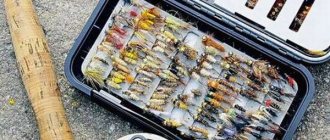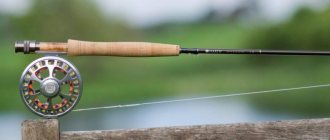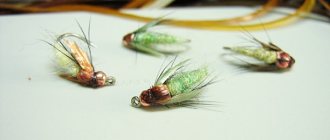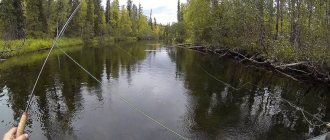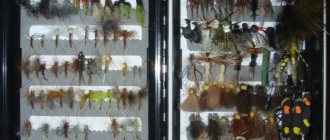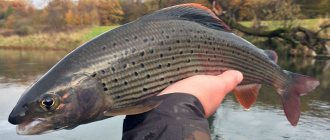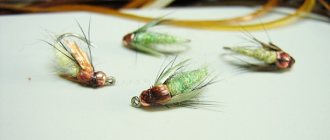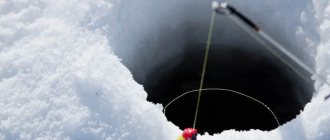I know a lot of fly fishermen. But I often meet people I don’t know while fishing who are mastering this wonderful fishing method. Of course, it's always interesting to see how others fish. And these observations led me to the conclusion that at least 70% of fly fishermen fish with dry flies. They get caught always and everywhere.
There is no doubt that such fishing has the right to life, just like any other. It is interesting, visual, effective, and even brings a healthy boost of adrenaline with every bite. But let’s remember that fly fishing, generally speaking, is very, very diverse and “fixating” on one of the approaches to fishing to some extent impoverishes the fisherman. Fishing with nymphs and wet flies, believe me, can give you many memorable and exciting moments. When I myself started practicing with nymphs, it was extremely difficult to get any useful information on this topic and, therefore, there was no need for a lot of stuff. Therefore, I want to share my experience with those who want to start fishing effectively using nymphs and wet flies.
Installation of gear
I offer two options. Option No. 1 (Fig. 1). Conical leader made of monofilament, leash 1 m long. Option No. 2. Braided leader or leader of different immersion speeds, leash 1 m long. Recommended set - Slow Sinking (SS), Extra Super Fast Sinking (ESFS). Fundamentally, these options differ in the presence of a kind of additional “sinker”, which is the sinking undergrowth. Both options are valid and fully capable. As, by the way, there are also many others. I’ll tell you a terrible secret and say that installation No. 2 is more effective when fishing with nymphs and wet flies and, most likely, you will come to it. But first, I’ll advise you on installation No. 1, as it’s easier to operate and less expensive financially (what if you don’t like nymph fishing). In both installation options, the last point is a nymph or a wet fly. Let's try to form a “nymph” working box.
Fly fishing with nymph
All forms of water beetles are also imitated. When you fish with a nymph, the most important thing is not the accuracy of the choice of the form that is imitated, but the accuracy and naturalness of the imitation. Whether the fish will then understand that the bait presented to it is nothing more than, unfortunately, an imperfect fake, is another question.Nymph fishing began around the same time as dry fly fishing.
Skuez is from Itchen in southern England. He discovered that brown trout, which are very difficult to catch, feed on mayfly larvae, which lay eggs just below the surface of the water.
When fishing for a nymph, the correct presentation of the fly is sometimes much more important than the degree of compliance with its prototype. It is very important to guide the fly so that it absolutely accurately follows the natural movements of the insect.
In 1895, Squez began experimenting with wet flies, casting them upstream, and significantly reduced their size, creating the first nymph lures. More than forty different, strictly copying models of nymphs originate there. He described his technique for nymphing near the surface of the water in many publications, most famously Nymph Fishing for the Chalk Stream Trout. Ernest Schweibert, one of the greatest American anglers of a later generation, in his monumental work Trout, draws the reader's attention to the fruitful correspondence between Skuez and James Leisenring, the founder of the American school of nymphing. Another great Englishman, Frank Sawyer, in 1950 managed to introduce among Europeans a completely different, but at the same time excellent technique for catching fish in deep water with a nymph. Sawyer's patterns are fairly lightweight and he only fished if he could see the fish. He thought about reducing the size of several nymphs to the size of the smallest imitable forms, which would perfectly suit this type of fishing. It was then that he created the feather tail fly, a classic mayfly style fly that is still one of the most popular nymphs in Europe today.
When fishing with a fly, depending on the type and activity of the fish, fishing occurs near the surface of the water, in middle water or at the very bottom. The point is to present the fly to the fish, following the behavior model of its prototype. In fast water this means drifting with small light movements, but in no case moving against the current; in still water the technique for fishing with a nymph is the same as with a wet fly.
The most “elegant” way to present a nymph to a fish is with the current or across it. When the fish habitually takes the nymphs just below the surface of the water, its movement towards the fly placed on the surface of the water is clearly visible, the fish “exposes” itself quite clearly. If we fish in the middle layers, then to see when the fish has taken, you need to have very trained eyesight even under the most favorable circumstances. If fishing is done near the bottom, the moment when the fish takes the bait can only be felt by a slight trembling of the cord or by a slight movement and stopping of the thin end of the fishing line. As soon as he stops, you need to hook him.
Near the surface of the water or in its middle layers, you need to fish for a nymph using a floating line. The moment when the fish took it is easier to see if you have a special cord for nymph fishing. In deep water, it is recommended to use a special line with a sinking tip, despite the fact that in this case it is much more difficult to feel the moment of a bite. A sinking line should only be used when fishing on a lake, when the line is periodically tightened, thereby maintaining constant contact with the nymph and thus significantly increasing the likelihood of feeling a bite.
There are a number of techniques for casting a fly using a floating line in deep water. But real depth can only be achieved with a sinking line with a long, heavy sinking leader and a weighted nymph. This method, of course, requires the ability to maintain complete control over the line and extensive experience as an angler. Methods of fishing in deep water can be more likely attributed to one of the types of fishing with a wet fly, and not to fishing with a nymph.
For nymph fishing, a sensitive rod with a length of at least 2.4 meters and a cord of class 4 - 5 is best suited. A light cord allows you to achieve the most accurate presentation and unhindered drift of the fly. In still water the latter aspect is of course irrelevant.
Nymph fishing can be considered one of the most elegant and artistic forms of fly fishing.
But it also puts the angler’s skill to a serious test. Below are photographs of insect larvae and their imitations in the form of flies.
Stonefly
Mayflies (Ephemeroptera)
Caddis
Dragonfly
Mosquito
How to catch
Let's start with the simplest approach, but take my word for it, it will bring you success. Find a section of the river with a fast current and a depth of up to 1 m (or better yet, even shallower). Moreover, the faster the current, the greater the chances of success. Because in the approach under consideration, guiding the nymph will not be entirely correct, and the fast current and shallow depth will smooth out the errors. Tie on a Gold Head with a brass head in gray or olive. When choosing a color, pay attention to the amount of underwater grass in the intended fishing area. If there is a lot of it, then use an olive-colored nymph. For general development, I will outline a fairly generalized approach to choosing the color of a nymph. For rocky bottoms, it is recommended to use gray nymphs, olive nymphs for places where there is underwater grass, and when fishing on a river with a sandy bottom, sand-colored nymphs are used, respectively. Although, by and large, you shouldn’t get hung up on choosing the color of the front sight. Go into the water and stand with your back to the current (Fig. 2). Cast at 45° to the left downstream for a distance of 5–7 m. Hold the line in your left hand. Wait until the line is completely straightened, then repeat the cast to the right. Take two steps downstream and repeat the casts. You will feel the bite along the cord held in your left hand, like a blow, a pinch, a jerk. In response to this, make a short wrist hook. If there are no bites, then place a fly with a tungsten head and repeat several postings. If the water is clear and the sun is shining, use black-headed nymphs.
If flies with heads don't produce bites, try placing a wet fly tied on size 12-14 hooks with a red or black head. Most often, when fishing, selecting and changing flies is one of the necessary factors for success.
Of course, the described approach is quite primitive, but it is quite legitimate and will undoubtedly bring you the first fish caught with a nymph or wet fly. I will immediately give a positive example of using the above algorithm. At one time, I tried for a long time and unsuccessfully to get clear advice on nymph fishing from the fly fishermen I knew. It should be noted that there was a lot of advice. But the next time we went fishing, it was followed, alas and ah, by another failure. And so again and again. Finally, I was lucky, one wonderful fly fisherman, still of the Soviet school, after listening to the lamentations about “this disgrace in the form of nymphs,” advised me what I offered to your attention above. Without putting things off for a long time, I rushed to the grayling river closest to Moscow, entered a shallow riffle, and threw it to the left. A bite followed almost immediately. Casting to the right, oddly enough, also brought fish. Subsequent fishing made me, as they say, “holier than the Pope” in relation to nymphs. But the story had an interesting continuation. A couple of days later, after, as you understand, more than colorful stories and, of course, instructions, I brought my friend, a fan of dry fly fishing, to this roll. We started fishing with “that same nymph.” Three hours later, without seeing a single bite, we moved to another riffle, where we caught quite well with dry flies. The funny thing is that more than ten years have passed since that fishing trip, and my friend still fishes with dry flies, completely ignoring nymphs. The contrast between my colorful stories and the realities without bites had a painfully negative impression on him. Now, of course, I understand that I was very lucky in that fishing trip. The fish were in the water column and were more than active. However, as you can see, even the most primitive approach can sometimes give a decent result. Although the main skills learned from this method of fishing with nymphs should be the feeling of the line and fly when retrieving, as well as timely perception of bites and, of course, the emergence of confidence in the effectiveness of “nymph” fishing.
Two popular fishing techniques: fly and nymphSergey Sidorov, 2012
Dry fly fishing technique
When presenting a dry fly, we must keep in mind what insect it is imitating. Most often our fly should float through the water as if it were not attached to a leader. And this is the basic rule that must be followed when fishing with this method.
But, as usual, every rule has its exceptions. A natural fly, such as a mayfly, can “slide” along the surface of the water due to the wind, a caddis fly bounces on the water, trying to take off. It is very difficult to imitate such movements, but fish often choose moving insects. It must be remembered that a live fly glides through the water without disturbing its surface. An artificial fly is partially submerged in water. Therefore, any movement we can give to the fly should be as small as possible. Nevertheless, when fishing for chub and trout, especially with caddis, you can allow more expressive movements of the fly, and even flood it a little at the end of the retrieve. Sometimes such a technique can provoke the grip of not only trout, but also grayling.
Sometimes when fishing with dry caddis imitation, short movements of the fly give the oscillating movements of the rod from side to side. As a result, the fly moves slightly, and the line lying on the water takes on a wave-like shape, which, when casting across the current, increases the free drift of the bait.
When retrieving a fly, we constantly monitor it so that if it bites, we can hook it in a timely manner. If we see a splash, we try to place the fly above this place and move it over it. If there is no bite, we allow the fly to swim below the fish site and repeat the cast. Fish fattenes differently. If the splashes are repeated in the same place, the casts must be made very accurately. Often this turns out to be the main condition for her to become interested in our fly. But it also happens that during intense feeding, the fish hunts for insects over a fairly large area. Then it is difficult to know whether we are dealing with one fish or a school.
Fish standing just below the surface of the water usually move around in search of food. Those located near the bottom feed in a rather limited field and most often eat insects swimming directly above them.
Types of casts.
The technique of placing a dry fly and hooking is largely determined by the direction of casting relative to the current. Most often, they try to position themselves towards a fish standing in the current so that the casts are made up against the current or, at least, up and across. Then the dry fly moves in accordance with the current, since it does not experience any additional influences of the water flow. If casts have to be made across and downstream, then sooner or later the cord straightening in the current begins to tighten the fly (Fig. 1). At the same time, it stands out sharply from the drift, moving unnaturally quickly to the side. For most fish, this behavior of the bait instantly kills their appetite. To prevent this from happening, we devoted so much time to studying fly casting options and manipulations that should ensure the possibility of dry fly fishing. Here we will again have to use an imaginary dial (Fig. 2) and try to summarize the already available information.
Rice. 1. Pulling the fly with the current
Rice. 2. Scheme for using casts
So, based on the direction of the flow, the following casts and their modifications are used:
“12.00” - casting with a straight line (STRAIGHT LINE CAST);
“1.30” - casting with a relaxed cord (SLACK LINE CAST), or better yet, a combination of casting with moving the cord to the left with the “Mending” maneuver (LEFT REACH CAST & MENDING);
“3.00” — cast with the line moving to the left (LEFT REACH CAST);
“4.30” - casting with the cord moving to the left and extending the cord (LEFT REACH CAST & FEEDING);
“6.00” - casting the most relaxed line and lengthening the line (MAXIMUM SLACK LINE CAST & FEEDING);
Let's complicate things a little
Next, we will try to complicate our actions a little, but this, accordingly, should have a positive effect on the number of bites. We do everything the same as in the previous case, with the exception of the actual casting itself. And there are no longer such strict requirements for current strength and depth. Before casting, wind about 1.5–2 m of line from the reel; this loop should hang freely below your left hand holding the line. Cast at 45° downstream. At the last stage of casting, ideally, when the line has straightened out but has not yet laid down on the water, release the supply of line from your left hand and try, with a wrist movement of your hand, to lay out a loop of the line towards the current (Fig. 3). This technique is called mending, and you will use it constantly in the future. A similar technique is used when fishing with a dry fly. There, a loop of line laid out against the current ensures natural floating of the dry fly. In our case, mending allows us to additionally solve the problem of quickly deepening the nymph. Next, carry out the wiring as in the case described above. You will feel the bites on the cord held in your left hand. When touching on the topic of bites, the question of using an indicator quite reasonably arises. This is a kind of device, essentially a banal analogue of a float. In our case, when wiring on an almost straightened cord, this very indicator is not needed, you will already feel the bite on the cord. When casting against the current, when the line has not begun to straighten, and you do not yet have the skill to see a bite by the movement of the line directly in the water, you can use an indicator. But this already applies to more “advanced” nymph fishing, which I will try to understand below.
Downstream - downstream
If a novice fly fisherman has a question about how to fish with a nymph, then, as a rule, they first explain the downstream fishing scheme, the so-called downstream method. The principle of this fishing is as follows. A cast is made upstream at an angle of 45° relative to the main stream, then mending is done, a special technique in which a loose cord is thrown upstream to reduce the pressure of the current jet on the cord. If you do not make such a transfer, then due to the pressure of the current the speed of the fly's passage increases, and this does not always have a favorable effect on the quality of the retrieve.
This technique allows you to deepen the fly, lower it closer to the bottom and pass it right in front of the fish’s nose. If the current speed is very high or the depth is large, you can make several mendings and thereby increase the depth of the retrieve and slow down the speed of the fly. After deepening, the bait swims through a section of the expected fish holding zone, and then it is stopped. First, the rod stops, and then the entire tackle. When the current pressure on the line increases, the fly begins to float, simulating an insect emerging from the water. This method is perhaps the most common and easiest to start mastering nymph fishing.
Directions of development
To further improve your fly fishing skills, you will need to master casting with casting, performed at different angles towards the current. After “setting up” such casts, you should experiment with the shape of the loop when casting, laid out towards the current. In general terms, the sharper this loop and the angle of casting in relation to the current, the faster the nymph sinks (Fig. 4). Try to evaluate the effect of the weight of the fly and its silhouette (thick/thin) on the speed at which it sinks. But remember that “reaching” the bottom with a fly is not synonymous with successful fishing. Very often fish bite in the water column more actively than near the bottom. Moreover, understanding the behavior of fish, the reasons influencing the mechanism of its feeding, and determining the feeding horizon is undoubtedly a more global and important task than mastering the technical features of nymph fishing. As you accumulate your own fishing experience in the process of communicating with colleagues in the hobby, answers to the formulated problem will come. But, generally speaking, nymph fishing requires constant close analysis of what is happening while fishing. For example, choosing flies for a specific fish at a certain point in time. The wide variety of nymphs and wet flies can be overwhelming. It is clear that there is no need to engage in global search and testing of them. Because it looks more like collecting than practical fishing. Decide what kind of fish and in what conditions you are going to catch. Now, fortunately, descriptions of many flies are available, which also include a link to a specific fish. Among the flies suitable for catching the fish you are interested in, there will undoubtedly be those that quite accurately imitate the underwater fauna of your region. The degree of realism of lures may vary, but there should be a general similarity. There are other approaches regarding the accuracy of the prototype display, but this is a topic for a completely different article. You should end up with 6-7 different types of nymphs and 3-4 types of wet flies in your box. At the same time, focus on the presence of baits of the same type, but of different sizes, weights and colors.
Good luck!
